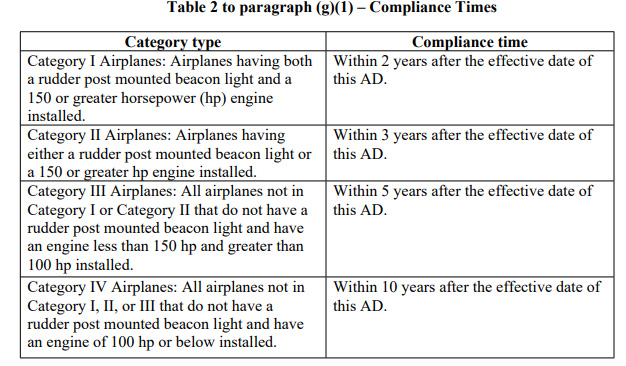FAA rejects modifications to Piper rudder AD
Final rule allows 2-10 years to replace rudders
The FAA rejected calls to limit the scope of an airworthiness directive published in final form on February 13, affecting an estimated 31,000 vintage Piper aircraft, all of which will need new rudders (or an approved alternative method of compliance) within the coming two to 10 years to remain airworthy.
The final rule, effective March 20, is largely unchanged from the proposed version published in October 2023, and the FAA rejected a range of arguments from AOPA and others seeking to limit the scope, or rescind the AD.
The FAA agreed to give certain vintage Piper owners more time to complete the required replacement of any rudder assembled with a rudder post made of 1025 carbon steel, creating a fourth compliance category with a 10-year deadline applicable to aircraft with no beacon light mounted on the rudder post and an engine of less than 100 horsepower.
The final AD applies to virtually all high-wing Piper models, from J-series Cubs through PA–22 Tri-Pacers. The directive was prompted by NTSB investigation findings in two incidents of in-flight rudder post fractures in 2020 and 2021 involving a Piper PA–12 and a PA–14, both equipped with rudder posts made of 1025 carbon steel. Both aircraft were flown in Alaska, and both landed safely following the rudder fracture.
The NTSB issued a report on those investigations in 2022, noting five known cases of Piper PA–12, PA–14, and PA–18 rudder post fractures, all involving aircraft with aftermarket beacon or strobe lights installed on the top of the rudder post.
The FAA rejected the assertion from commenters including The Short Wing Piper Club that because the aircraft that experienced in-flight rudder post fractures landed safely, the condition is not unsafe: "Just because airplanes have been able to land safely does not mean that rudder post failure would not present an unsafe condition," the agency responded.
The FAA also disagreed with commenters who stated that producing replacement rudders for 31,000 out-of-production aircraft is not possible.

"Many of the 31,000 airplanes are not currently in service," the agency wrote. "There are an estimated 13,000 active airplanes in the U.S. fleet, and the FAA estimates that approximately half of those airplanes already have rudder assemblies with 4130N low-alloy steel installed. This reduces the number of rudders needed to approximately 6,500." The FAA notes that Piper Service Bulletin 1379B issued May 7 (an update of a 2022 bulletin on the same topic) provides information on how to determine whether a rudder post is made of 4130N low-alloy steel, which would eliminate the requirement to replace the rudder assembly. Service Bulletin 1379 described how a single drop of nitric acid applied to the metal will produce an instant reaction if the material is 1025 carbon steel, and no reaction otherwise. Generally, aircraft produced before June 3, 1974, were built with 1025 carbon steel rudder posts.
The FAA "anticipates" that authorized parts manufacturers "can produce the necessary rudder assemblies within the compliance times of this AD. The FAA cannot base its AD action on whether spare parts are available or can be produced. While every effort is made to avoid grounding airplanes, the FAA must address the unsafe condition."
The FAA ruled out the option of conducting rudder post strength tests, noting that such inspection would require the removal of rudder covering material, and load testing is "problematic because the load test could further damage the rudder and contribute to an accident." The agency notes that owners or operators who wish to implement an inspection program in lieu of rudder replacement may submit an AMOC request.
The agency also disagreed with challenges to the estimated cost of the required rudder replacement, which remains unchanged from the originally proposed AD: $3,000 per aircraft, including $2,320 for a new rudder assembly (including a post made from 4130N low-alloy steel), and $680 in labor (eight hours at $85 per hour).




